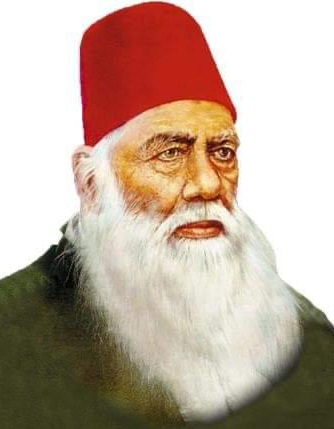SIR SYED DAY
In a speech at Patna on January 1883, writings and speeches of Sir Syed Ahmad Khan. He stated, “India is like a bride which has got two beautiful and lustrous eyes Hindus and Mussulmans. If they quarrel against each other that beautiful bride will become ugly and if one destroys the other, she will lose one eye,”. Sir Syed Ahmad Khan believed in bringing people together, no matter their religion. In a speech at Gurdaspur on January 27, 1884, he asked everyone to remember their shared home in India. He said, “Oh Hindus and Mussalmans, do you inhabit any country other than India? Do you not both live here on the same land and are you not buried in this land or cremated on the ghats of this land? You live here and die here. Therefore remember that Hindu and Mussalman are words of religious significance otherwise Hindus, Mussalmans and Christians who live in this country constitute one nation.”
The Alig Fraternity celebrates Sir Syed Day worldwide every year on October 17th. This day marks the birth anniversary of Sir Syed Ahmad Khan, the founder of Aligarh Muslim University, and is also known as ‘Eid-e-Alig.’ The celebrations are filled with grandeur and excitement. However, people often overlook Sir Syed’s other contributions to society, focusing only on his role in establishing the university. Sir Syed Ahmad Khan, born on October 17, 1817, is considered the savior of Muslim education. He lived in a time when traditional and modern education systems were mixed, often turning into religious learning. Convincing people to accept the new education system was like introducing a new faith to a society deeply rooted in its religious beliefs. In 1835, most of the Muslim community filed a petition against the new British education system, fearing it would lead to the conversion of the entire country to Christianity. Despite this, Sir Syed was the first to see the advantages of English education for Indians. While he believed in resisting British rule, he did not oppose English education.
Sir Syed Ahmad Khan established a madrassa in Moradabad in 1859 that combined modern education with religious teachings. Later, in 1863, he founded another madrassa in Ghazipur, which eventually became known as Victoria High School. To push forward educational reforms, he also created the ‘Scientific Society.’ However, when he moved to Aligarh in 1865, he relocated the Scientific Society and renamed it ‘Scientific Society Aligarh.’ After recognizing the educational backwardness of the Muslim community, Sir Syed aimed to connect his community with Western education. He researched why they were avoiding government schools and discovered that the main reason was a deep fear of English education. Determined to help them progress, he worked to integrate them into the modern education system.
Sir Syed Ahmad Khan understood that Indians could reach greater heights with the help of Western knowledge in arts and sciences. However, his path was difficult. He faced criticism, harsh rebukes, and condemnation. Religious leaders and other conservative members of the community accused him of leading people astray. They believed that English education would distance Muslims from their faith and corrupt their minds. Some even went so far as to label him a non-believer. Despite this, Sir Syed, with unshakable determination and focus, remained steadfast in his mission. He pressed on and stood firm. He formed a committee to promote education for the masses, although the group faced strong opposition.
Critics claimed that English education would create a generation lacking beliefs and moral values. Yet, Sir Syed and his supporters never gave up hope. Their persistent efforts eventually led to the founding of the ‘Mohammadan Anglo Oriental College’ (MAO College) in 1875, which later became Aligarh Muslim University in 1920. Sir Syed had traveled to England to closely study the education system there. Unable to afford a famous architect, he personally drew the designs for the college buildings. His vision was to create an institution modeled after Oxford and Cambridge. He shared this vision in an article in 1872, which was reprinted in the Aligarh Institute Gazette (a publication he had been running since 1866) in 1911.
After establishing MAO College, Sir Syed recognized the urgent need for financial support to sustain the institution. He wrote letters to many prominent individuals and went from door to door seeking donations. His determination went further—he even took to the stage during a Nautanki performance, urging people to contribute just one rupee for children’s education. On one occasion, a woman angrily threw a worn-out slipper at him when he asked for a donation. Sir Syed calmly accepted it, repaired the slipper, and sold it in the market, using the proceeds as a donation. He even sent a receipt of this donation to the woman. Despite facing insults and humiliation many times, Sir Syed never wavered in his mission.
Sir Syed Ahmad Khan was not only an educator but also an outstanding writer. After the revolt of 1857, he authored the book ‘Asbab-i-Bagawat-e-Hind’, where he argued that the true cause of the uprising was the dissatisfaction and discontent among soldiers, which sparked a nationwide revolt against the British Government. His analysis of the causes in the book was widely discussed and eventually accepted by the government.
Sir Syed’s literary talent was also evident in his other work, ‘Asar-us-Sanadid’. While serving as a Munsif in Delhi, he decided to research the historical buildings in Delhi and its surrounding areas. Although it was a difficult task, he was determined to complete it. Many of the buildings were in such poor condition that the inscriptions were unreadable, and some had fallen into ruins. Measuring the dimensions of these structures and reproducing copies of the inscriptions was a challenging endeavor.
To overcome these challenges, Sir Syed employed different techniques based on the needs of the task. For example, to read the inscriptions on the high walls of the Qutub Minar, he would sit in a basket suspended between two scaffolds, level with the inscriptions. Seeing him in that precarious position often worried the people around him. No one could have imagined that this ordinary child would one day become a prominent leader of the community. Sir Syed achieved remarkable success over thirty years, but it did not come without challenges. His teachings and methods remain relevant today, showing the path of a true scholar.
When Muslims around the world were protesting William Muir’s book ‘Life of Mahomet’, Sir Syed chose not to join the debate. He understood that violent reactions would portray the religion and community as intolerant. Instead, he decided to travel to England to verify the sources Muir used in his book. Though he was hurt and offended, he carefully studied the materials cited by Muir, available at various libraries and the British Museum. Rather than responding with anger, he took eight years to produce a scholarly rebuttal, ‘Khutbat-e-Ahmadiya’, in 1870. He even had the book translated into English, effectively countering the misconceptions created by Muir’s work.
Sir Syed was a strong believer in communal harmony and a champion of Hindu-Muslim unity, famously referring to the two communities as the “two eyes of the nation.” His close relationships with Swami Vivekananda, the philosopher and monk, and Debendranath Tagore, the 19th-century philosopher and religious reformer, are well-known. In his effort to promote religious tolerance, Sir Syed opposed cow slaughter during Eid-al-Adha, further promoting peace and understanding. Numerous incidents highlight Sir Syed’s commitment to humanity and peace.
In 1873, there were strong reactions to intolerable remarks in a book translated by a Parsi individual. In response, Sir Syed wrote an editorial for The Aligarh Institute Gazette, stating that violent outrage over blasphemy could never be justified. He believed that mindless violence would only lead to more conflict. Just a year before his death in 1897, when a Christian author published a book criticizing the Prophet Muhammad’s (PBUH) four wives, Sir Syed composed a scholarly rebuttal to address the claims.
Sir Syed was a contemporary of Mirza Ghalib and Akbar Allahabadi. He met Ghalib to request a foreward for his commentary on ‘Ain-e-Akbari’, which left a significant impression on him. During their meeting, Ghalib encouraged Sir Syed to focus more on the current conditions facing the community.
The commemoration of Sir Syed should extend beyond just Sir Syed Day. We must embody his values in our actions. As a reformer, progressive thinker, and champion of humanity, Sir Syed’s principles are essential today. The guidance and wisdom he provided remain relevant for the younger generation. He imparted valuable lessons in humanity that we should adopt to create a better world for future generations.
However, Pandit Jawaharlal Nehru, the former Prime Minister of India, said about Sir Syed Ahmad Khan: “An ardent reformer who wanted to reconcile modern scientific thought with religion by rationalistic interpretations and not by attacking the basic belief. He was anxious to push new education. He was in no way communally separatist. Repeatedly he emphasized that religious differences should have no political and national significance.”(Discovery of India).
(Author is Professor in Comparative Literature and Former Media Advisor of Aligarh Muslim University. Email: [email protected])








